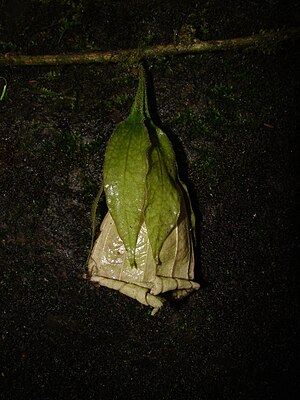Trianaea
| Trianaea | ||||||||||||
|---|---|---|---|---|---|---|---|---|---|---|---|---|

Trianaea |
||||||||||||
| Systematics | ||||||||||||
|
||||||||||||
| Scientific name | ||||||||||||
| Trianaea | ||||||||||||
| Planch. & Linden |
Trianaea is a plant genus of the family of the nightshade family (Solanaceae). The representatives of the genus usually grow as epiphytes in the treetops in remote forests of northwestern South America .
description
Vegetative characteristics
Trianaea are mostly epiphytic plants that sit on the host plant about 4 to 6 m above the ground, enclose them with their roots in a network and can grow as lianas up to 15 m long or as bushes up to 6 m high. Often a woody knot is formed from which long branches grow. Trianaea only grow as small trees in exceptional cases.
The plants are mostly hairless, only occasionally they are covered with simple or glandular trichomes . The leaves are large, thick, shiny and leathery or even slightly fleshy. The leaf blade becomes (rarely only 5) 10 to 25 (rarely up to 31) cm long and (2.4) 3 to 12 (15) cm wide, it is elliptical, ovoid-elliptical, inverted ovoid-elliptical or closely inverted ovoid , rarely also linear-elliptic or narrowly linear. The base is tapered, the tip tapering. The leaf stalks are 0.5 to 2 (5) cm long.
blossoms
The large, showy, terminal or stem-like flowers in the leaf axils are solitary or form inflorescences of two to three flowers. They are usually fivefold, only rarely fourfold. They hang on usually 18 to 26 cm or more rarely only 3.5 to 10 cm long flower stalks. The bell-shaped calyx is 4 to 7 cm long, five-angled and usually as long as the corolla tube. The calyx lobes are triangularly pointed and longer than the calyx tube. Except for a short, basal, tubular area, the crown is funnel-shaped, it becomes (5) 6 to 10 (12) cm long. The color of the crown is white, yellowish, greenish-yellow or yellowish-brown. The corolla lobes are rounded and bent back, the edges are bent upwards.
The stamens are slightly above the crown. The stamens, which are fixed about 5 to 8 mm above the base of the crown, are straight, awl-shaped and hairy at the base and bent over to form a knee. They are three to four times longer than the linear anthers and are attached to their front. The anthers are usually 13 to 20 × 3 to 4 mm in size, only in Trianaea naeka they are about 7 × 3 mm in size. The theka of the anthers are not grown together. The pollen is medium-sized with a diameter of 26 to 34 µm, the pollen grain wall ( exine ) is 1 to 1.2 µm thick and designed like a network. The ovary is conically shaped, five- or occasionally four-chambered, with ten or eight ovary compartments. The straight stylus is terminal. The scar has five or four lobes. Nectaries are clearly developed. The flowers are fertilized by bats .
Fruits and seeds
The fruits are indented spherical or ovate-elongated berries with a diameter or length of (3) 5 to 7 (10) cm. Occasionally the fruits are cylindrical with a size of 7 to 10 × 3 to 5 cm. The fruits, which are yellow when ripe, are partially covered by the permanent calyx. The seeds are elongated kidney-shaped, thin and (2) 2.5 to 2.8 (3) × 1.2 × 0.5 mm in size, occasionally strongly curved near the hilum , the edge of the seed is strongly wavy. The cells of the seed coat are not elongated. The worm-shaped embryo is curved, the cotyledons are perpendicular to the rest of the embryo and are shorter but not wider than this. Endosperm is abundant.
distribution
The species of the genus are native to the tropical rainforests of northwestern South America, where they grow at altitudes from 800 or 1,000 m to 2,500 m. The plants are rare and grow in hard-to-reach locations.
Systematics
So far, six different species have been described in the genus Trianaea . Since, however, due to the poor representation of the genus in herbaria or the poor condition of the type specimens and the poor findability in the wild, hardly any statements can be made about the validity of the species, Armando Hunziker's work "The Genera of Solanaceae" only lists two Species recognized as safe:
- Trianaea naeka S.Knapp : It was first described from Ecuador.
- Trianaea nobilis Planch. & Linden
The other four described species with unsafe status are:
- Trianaea brevipes (Cuatrec.) S.Knapp
- Trianaea neovisae Romero
- Trianaea speciosa (Drake) Soler.
- Trianaea spectabilis Cuatrec.
The type species is Trianaea nobilis .
literature
- Armando T. Hunziker: The Genera of Solanaceae . ARG Gantner Verlag KG, Ruggell, Liechtenstein 2001. ISBN 3-904144-77-4 .
Individual evidence
- ↑ Subordinate taxa Trianeae in Tropicos database of the Missouri Botanical Garden .